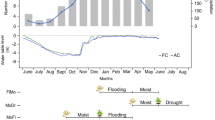Abstract
We studied seedling survival and growth of Aquilaria malaccensis in three different environmental conditions (homegardens, green house and in different canopy conditions) of northeast India. Results show that mean seasonal survival was highest in green house (95.53%±2.33), followed by homegardens (89.3%±1.89) and different canopy conditions (77.62%±6.73); the highest values were found during February to April for both the homegardens (96%±1.68) and green house (98% ± 0.88) and lowest during November to January (78%±2.99) in homegardens and May to July (90%±4.53) in green house. In case of transplanted seedlings in different canopy conditions, mean seasonal survival was highest during May to July (98%±1.92) and lowest during August to October (66%±12.81). However, mean seasonal growth of collar diameter was highest in different canopy conditions (23.99%±1.76 compared to green house (21.52%±2.70) and homegardens (12.44%±1.33) and it was highest during rainy season (May to July) and lowest during dry winter (November to January) in all the three experimental sites. These variations may be due to the different microclimatic conditions as well as nutrient status of the soil in all the three experimental sites. Although, seedling quality plays a great role in their survival and growth, based on the result of green house experiment, it can be concluded that maintenance of seedlings in green house conditions during their early growth period may improve both the survival and growth for large scale plantation of the species. Thus, the species can be reintroduced in its natural forest range to compensate the loss of natural population of this precious species in northeast India.
Similar content being viewed by others
References
Augspurger CK. 1984. Seedling survival of tropical tree species: Interactions of dispersal distance, light gaps and pathogens. Ecol, 65: 1705–1712.
Baker FS. 1949. A revised shade tolerance table. Journal of Forestry, 47: 179–181.
Beniwal BS. 1989. Silvical characteristics of Aquilaria agallocha Roxb. Indian For, 5: 17–21.
Bhuyan P. 2002. Ecological studies on seed production, dispersal, germination and seedling fitness of Rudraksh (Elaeocarpus ganitrus Roxb.), Ph.D. Thesis, Department of Botany, North-Eastern Hill University, Shillong, Meghalaya, India.
Brokaw NVL. 1985. Gap phase regeneration in a tropical forest. Ecol, 66: 682–687.
Clark DB, Clark DA. 1985. Seedling dynamics of a tropical tree: impacts of herbivory and meristem damage. Ecol, 66: 1884–1892.
Denslow JS. 1980. Gap partitioning among tropical rainforest trees. Biotropica Suppl, 12: 47–55.
Khan ML, Rai JPN, Tripathi RS. 1986. Regeneration and survival of tree seedlings and sprouts in tropical deciduous and sub-tropical forests of Meghalaya, India. For Ecol Manag, 14: 293–304.
Khan ML, Tripathi RS. 1991. Seedling survival and growth of early and late successional tree species as affected by insect herbivory and pathogen attack in sub tropical humid forest stands of NE India. Acta Oecol, 12: 569–579.
Khan ML, Uma S. 2001. Effect of seed weight, light regime and substratum microsite on germination and seedling growth of Quercus semiserrata Roxb. Trop Ecol, 42: 117–126.
Khumbongmayum AD, Khan ML, Tripathi RS. 2005. Survival and growth of seedlings of a few tree species in the four sacred groves of Manipur, Northeast India. Curr Sci, 88: 1781–1788.
Khumbongmayum AD. 2004. Studies on plant diversity and regeneration of a few tree species in the sacred groves of Manipur, Ph.D. Thesis, Department of Botany, North-Eastern Hill University, Shillong, Meghalaya, India.
Kumar R, Singh AK, Abbas SG. 1994. Change in population structure of some dominant tree species of dry Peninsular Sal Forest. Indian For, 120: 343–348.
Lieberman D, Li M. 1992. Seedling recruitment patterns in a tropical dry forest in Ghana. J Veg Sci, 3: 375–382.
Nagamastu D, Seiwa K, Sakai A. 2002. Seedling establishment of deciduous trees in various topographic positions. J Veg Sci, 13: 35–44.
Philips OI, Gentry NH. 1994. Increasing turnover through time in tropical forest. Science, 263: 954–958.
Rao P, Barik SK, Pandey HN, Tripathi RS. 1997. Tree seed germination and seedling establishment in treefall gaps and understory in a subtropical forest of northeast India. Aus J Ecol, 22: 136–145.
Ray GJ, Brown BJ. 1995. Restoring Caribbean dry forests: evaluation of tree propagation techniques. Restor Ecol, 3: 86–94.
Saikia P, Choudhury BI, Khan ML. 2012. Floristic composition and plant utilization pattern in homegardens of Upper Assam, India. Tropical Ecology, 53: 105–118.
Schulte PJ, Marshall PE. 1983. Growth and water relations of black locust and Pine seedlings exposed to controlled water-stress. Can J For Res, 13: 334–338.
Soehartono T, Newton A, Mardiastuti A. 2002. Factors influencing the survival and growth of Aquilaria malaccensis seedlings in Indonesia. J Trop For Sci, 14: 364–378.
Sork VL. 1987. Effect of predation and light on seedling establishment in Gustavia superba. Ecol, 68: 1341–1350.
Upadhaya K, Barik SK, Adhikari D, Baishya R, Lakadong NJ. 2009. Regeneration ecology and population status of a critically endangered and endemic tree species (Ilex khasiana Purk.) in NE India. Journal Forestry Research, 20: 223–228.
Author information
Authors and Affiliations
Corresponding author
Additional information
Foundation project: The project was financially supported by DBT, Govt. of India through the project “Mapping and quantitative assessment of geographic distribution and population status of plant resources of Eastern Himalayan Region”.
Rights and permissions
About this article
Cite this article
Saikia, P., Khan, M.L. Seedling survival and growth of Aquilaria malaccensis in different microclimatic conditions of northeast India. Journal of Forestry Research 23, 569–574 (2012). https://doi.org/10.1007/s11676-012-0296-7
Received:
Accepted:
Published:
Issue Date:
DOI: https://doi.org/10.1007/s11676-012-0296-7




